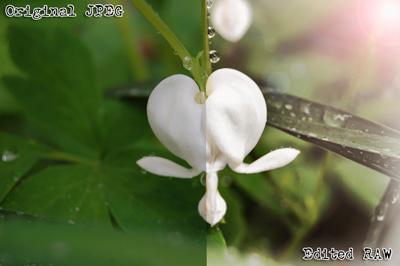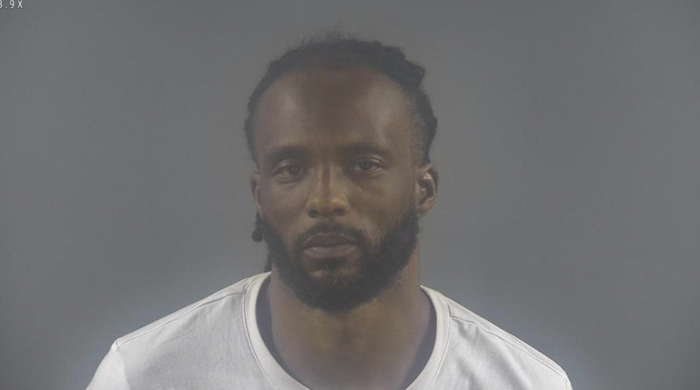Finding New Opportunities in Old Work
Published 12:00 am Tuesday, May 31, 2011

- Bleeding Heart before and after showing JPEG and edited RAW2. Photo by Amber Flowers of soulgazephotography.com
Walking down the hallway to your office, you pass by your family photos. The majority of them are your work. You’ve seen them so many times you barely pass a glance. Arriving in your office, you decide to upload your recent photography to your collection online. With some pride you flip through your work confident that your friends and family all love your photography. Whether you’re into photography as a hobby or business, share your photography on a website, Facebook or other source, are you 100% sure that your work is the best it could be?
All photographers, regardless of skill level, improve over time. There are no perfect photographers; we all make mistakes and have more to learn. Most photographers look to online sources, books or fellow photographers for assistance. One forgotten source is to pull out your old prints and digital files or negatives and examine your old work. If you are asking yourself how this could possibly make you better, then that is even more reason for you to do it.
Most photographers have upgraded cameras or improved their editing workflow with new software over the years. Regardless of the changes, for the most part, their style still resembles their old work in its similarities. What do these older images tell you about your skills then compared to now? Examine things such as focus, exposure and composition. Chances are, if you take the time to look, you’ll realize there are things you would’ve done differently were you there now. Just as athletes replay videos of former competitions to learn from them, photographers can do the same thing by looking back at their work. Looking back and realizing your mistakes make you a better photographer by helping you learn what you did wrong and how to do it better.
After examining your work, take the time to be critical and find the ‘flaws’ you may have missed. If you have the time and opportunity, return to those locations and photograph the subject again with your current skills. Return home and compare the difference. By doing this you’ll be refreshing your work and also testing your skills. This enables you to improve those skills by actively comparing where you were to where you are. Above all don’t be discouraged! If your skills haven’t changed, consider that a reason to practice more and try new things. If your work is significantly better, think about selling prints of your work online, locally in art galleries or sharing your knowledge with other photographers via joining a photography club or blogging.
Another consideration is your editing. If you have the originals you can re-edit them for much improved image quality. Some photographers avoid editing, completely relying on in-camera JPEG files. JPEG is a common format, but lacks advanced editing compatibility. Other photographers prefer to photograph in RAW+JPEG or RAW only. Shooting in RAW gives you the ability to enhance and edit in ways you can’t with JPEG files. Some examples are exposure and white balance. These settings can be changed in your camera’s menu, so consult your manual and confirm if you have the option. Whichever you use depends on your preference, but if you ever plan to edit your images shoot in RAW+JPEG. This fills up your memory card faster, but you’ll still have those familiar JPEG files and can archive the RAW files for when you need them. Many times images that are overexposed as JPEG files can be saved if they are RAW and edited in software that handles RAW. Commonly used programs are: Adobe Photoshop, Elements and Lightroom, Capture NX2, Phase One Capture One Pro and many more. If instead, you prefer only minor editing, there are various free programs available for download such as Google’s Picasa for editing brightness and contrast. Even if you don’t think you’ll ever want to do any advanced editing, download one of the larger RAW program’s free trials (available via the company’s websites) and try them out. You may discover you can’t live without the enhanced editing capabilities they provide. Just be cautious that your work doesn’t depend on editing so heavily that you can’t recognize the beauty without it. Above all, always save your original image files. That ensures you will have them if your editing preferences change.
You might feel your old work is great and your editing style is perfect. Your workflow is fast and efficient and your photography is exactly where you want to be. Some may instead feel that their work is gradually improving, but has remained the same. Regardless, there is no photographer of any skill level that is an expert with perfect work. How your work looks to you is not how it will look to someone else. You may see no flaws, but someone else will find one. You may see flaws, but someone else will see perfection. Photography is a matter of personal taste and preference just as with any art. While it’s great to follow the common rules of photography such as composition, it’s just as great to follow your own sense of style. Stay true to you, while still learning and adapting to new technology and software. Take the time to find new opportunities in your old work and you just may surprise yourself with how far you’ve come.
 About the author: Amber Flowers, Owner of Soul Gaze Photography, is a photographer, digital artist and writer most known for her infrared photography and the ‘fine art’ feel to her work. She is Founder of Southern Kentucky Photographer’s Club and a member of The League of Creative Infrared Photographers. Amber resides in Glasgow KY with her Husband, two children and several pets. Learn more, ask questions or purchase fine art photography: www.soulgazephotography.com
About the author: Amber Flowers, Owner of Soul Gaze Photography, is a photographer, digital artist and writer most known for her infrared photography and the ‘fine art’ feel to her work. She is Founder of Southern Kentucky Photographer’s Club and a member of The League of Creative Infrared Photographers. Amber resides in Glasgow KY with her Husband, two children and several pets. Learn more, ask questions or purchase fine art photography: www.soulgazephotography.com






